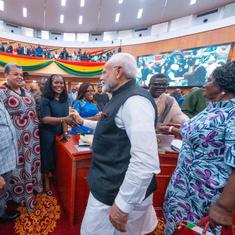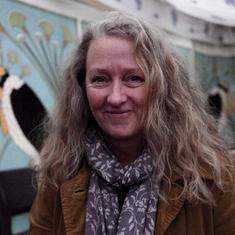A journey on Lahore’s arterial Ferozepur road is a trip down memory lane. Starting from the walled city of Lahore, the road connects several small ancient hamlets on the way, including Ichra, Mozang, Amar Sadhu, Kasur, until it ends at Ferozepur. Abruptly, somewhere in its path, a boundary fence appears, manned on each side by two of the largest armies in the world, armed to their teeth with nuclear arsenal that has the potential to stop the rotation of the earth in its orbit.
Connected by an ancient bond that not even the ravages of history, including Mongol, Afghan, and British colonialism, could cut, the bond between Lahore and Ferozepur was finally ripped apart by the creation of two new nation-states in 1947. The Ferozepur road now forlornly flows through Lahore, hastily abandoning its destination at the first sight of armed soldiers, betraying the traveler, even as the city it was named after now falls across the border, in
Located on the road facing a multi-storied IT tower is a shiny metaphor of a modern Lahore, the Gulab Devi hospital, sprawling across a lavish 40 acres in an increasingly congested city. The name pricks at the conscience of new citizens who were born and raised in a city that only knew Pakistan. This name too would have been erased, like so many others were after Partition, when the multi-religious Lahore of the past, with its several temples, gurudwaras, churches, mosques and dargahs, gave way to a new homogenous city and any reminder of the time when India and Pakistan were one was jettisoned to keep afloat a new nationalist project. But Gulab Devi survived because this hospital was run by a trust, one of whose conditions was that the name cannot be changed.
Past is present
The hospital is named after Lala Lajpat Rai’s mother, who died of tuberculosis in Lahore and owned by the trust formed by the freedom fighter and politician in 1927. Unfortunately, before Lala Lajpat Rai could see his dream through, he too died after he received a blow to his head during a police-led lathi charge at the Lahore Railway Station, where he was a leading a procession to protest against the Simon Commission. The hospital was inaugurated by Mahatma Gandhi in 1934.
The protest against the Simon Commission – which was to decide on constitutional reforms for India but did not count a single Indian as its member – and Lala Lajpat Rai’s death prompted the Indian National Congress to form a commission to propose constitutional reforms for India. The Nehru Report, penned by Motilal Nehru, which sought dominion status under the British Empire, was the first step towards the Congress demanding self-government.
The Nehru Report was perhaps the logical next step after Gandhi’s non-cooperation movement launched in 1920. As Indians across the country were encouraged to boycott government councils, courts and schools as well as foreign goods, the National College was founded in Lahore by Lala Lajpat Rai, to meet the education needs of the youth of the country who were staying away from British institutes.
The college was housed in the Bradlaugh Hall building, a red-brick structure that is a beautiful amalgamation of colonial and indigenous architectural traditions. Located a few streets away from here is the office of the Superintendent of Police, where Bhagat Singh and his comrades assassinated officer John P Saunders to avenge Lala Lajpat Rai’s death. Now permanently blocked, the Bradlaugh Hall building was where that Bhagat Singh and his friends received their initial doses of nationalism. During Bhagat Singh’s trial in Lahore, his parents used to receive visitors and sympathisers outside this structure.
Even though Bhagat Singh had parted ways with the Congress, disillusioned by what he perceived to be their passive nationalism, the impact of his revolutionary fervour resonated with the party’s younger cadre . Rejecting his father’s proposal demanding self-government with dominion status within the Empire, Jawaharlal Nehru along with Subhas Chandra Bose raised the demand for complete independence and the breaking of all ties with the British Empire. His efforts finally culminated in the Purna Swaraj Declaration (Declaration of the complete independence of India) of 1930. In a cold night in Lahore, as mist descended from the sky, Congress President Jawaharlal Nehru hoisted the tricolor flag of India in Minto Park, under the shadows of Badshahi Masjid, Gurudwara Dera Sahib and the Lahore Fort. In front of hundreds of thousands of people, the party officially promulgated the Purna Swaraj Declaration on the January 26, 1930.
From then on, till India was freed from British rule, January 26 was celebrated by the party as a symbolic independence day. After Independence, when India adopted its Constitution on January 26, 1950, this symbolic date went on to be celebrated every year as India’s Republic Day.
Lahore Resolution
Today, Minto Park is called Iqbal Park. At the centre of this green space is a tall minaret, Minar-e-Pakistan, which commemorates the Lahore Resolution that was adopted here by Muslim League between March 22 and 24, 1940. The resolution demanded provincial autonomy for a section of contiguous units that had a Muslim-majority population. Gradually, after the creation of Pakistan, this was re-appropriated as a demand for a separate country Pakistan and the Lahore Resolution was renamed Pakistan Resolution. Every year, March 23, the country celebrates Pakistan Day.
Every day thousands of visitors descend upon Minar-e-Pakistan, paying homage to the founders of the country. In popular political discourse, politicians refer to this momentous moment in the history of our country. Accolades are showered on the political significance of Lahore, home of Pakistan’s movement.
Perhaps consciously or out of ignorance, Lahore’s contribution to India’s freedom movement is never mentioned. Nehru’s declaration of Independence, Lala Lajpat Rai’s protest against Simon Commission and Bhagat Singh’s sacrifice have now been forgotten in the city where once they were warmly received.
As India last week celebrated its Independence Day, the streets of Lahore carried on their business unaware of the role they once played in earning the country its freedom.
Haroon Khalid is the author of three books: In Search of Shiva, A White Trail, and Walking with Nanak










